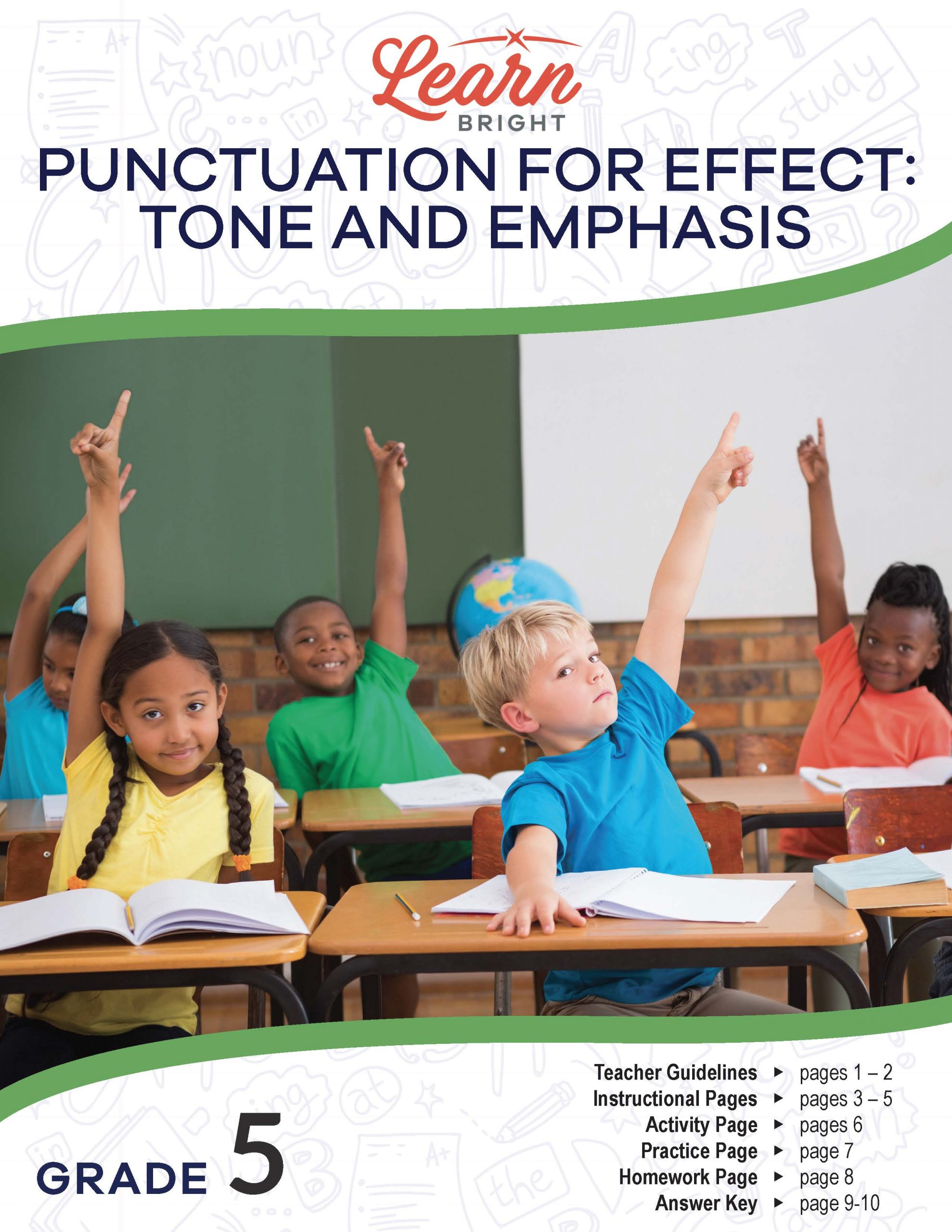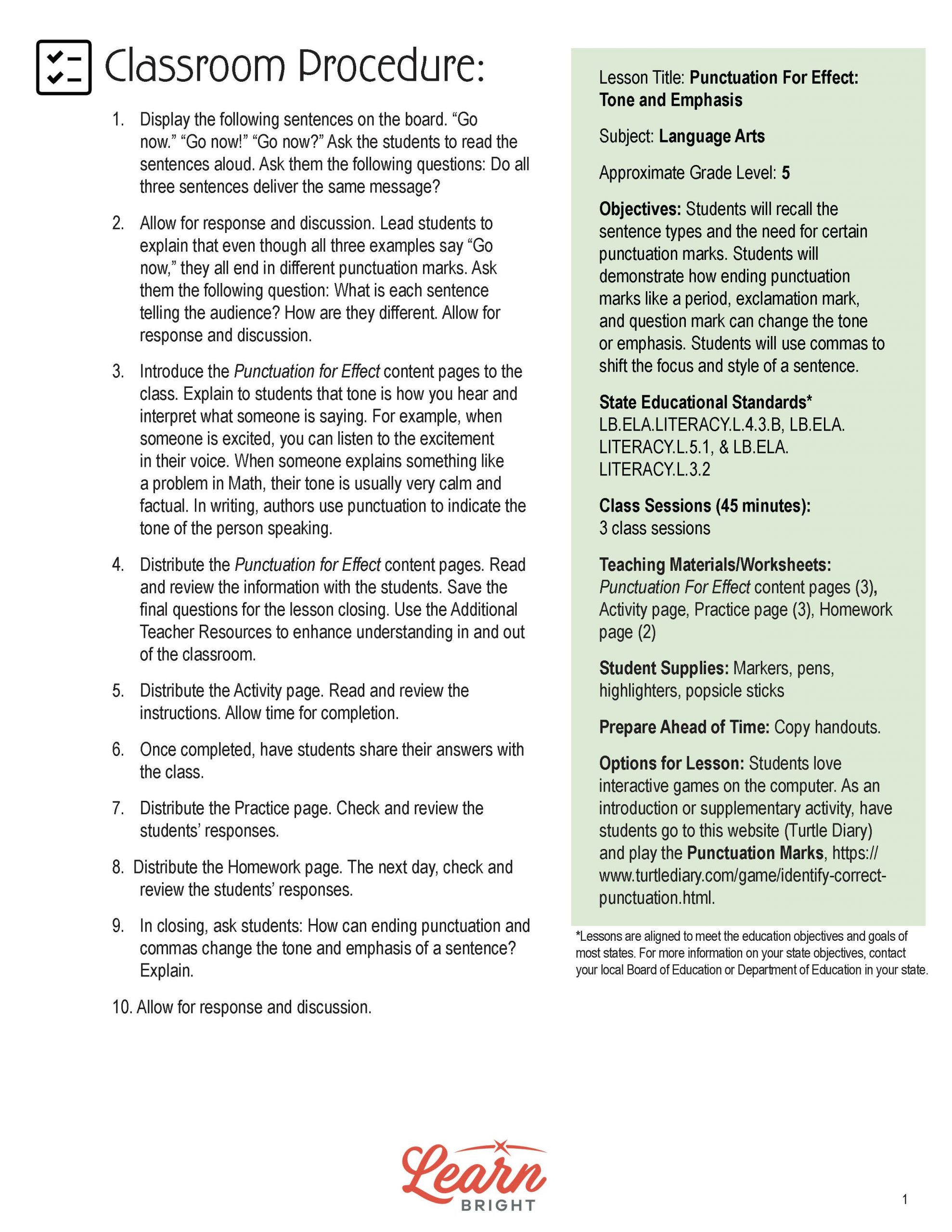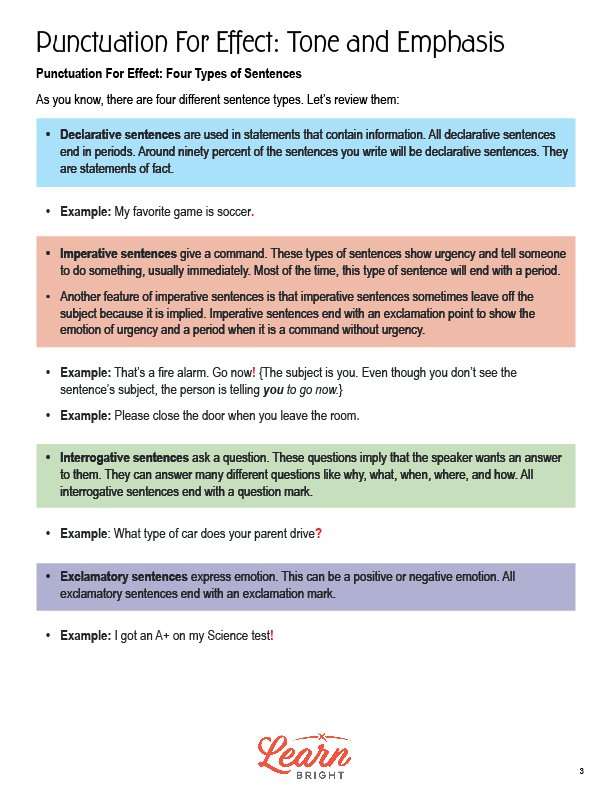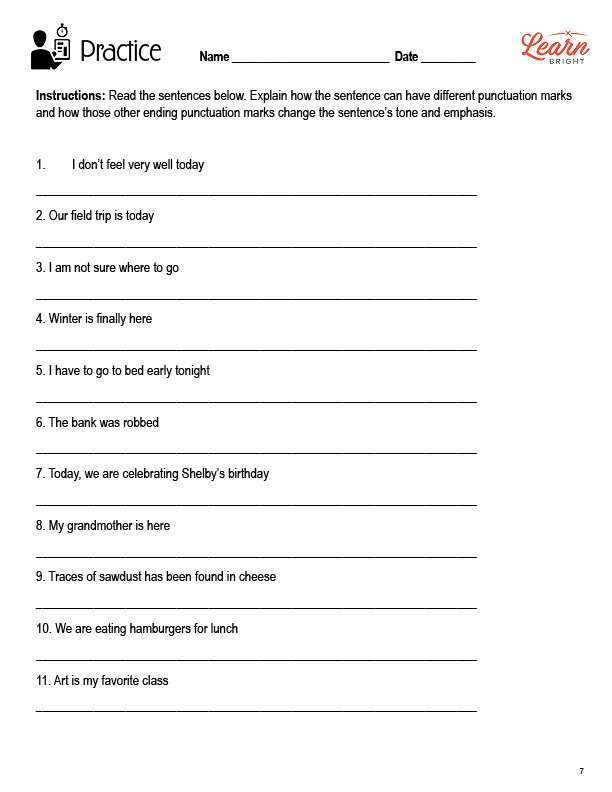Description
What our Punctuation for Effect – Tone and Emphasis lesson plan includes
Lesson Objectives and Overview: Punctuation for Effect – Tone and Emphasis teaches students how to use punctuation marks to achieve different results. They will learn about using question marks, exclamation marks, and commas to affect sentences in different ways. Students will review sentence types in this lesson, but the focus will remain on end punctuation. This lesson is for students in 5th grade.
Classroom Procedure
Every lesson plan provides you with a classroom procedure page that outlines a step-by-step guide to follow. You do not have to follow the guide exactly. The guide helps you organize the lesson and details when to hand out worksheets. It also lists information in the green box that you might find useful. You will find the lesson objectives, state standards, and number of class sessions the lesson should take to complete in this area. In addition, it describes the supplies you will need as well as what and how you need to prepare beforehand. The supplies you will need for this lesson are markers, pens, highlighters, and popsicle sticks. To prepare for this lesson ahead of time, you can gather the supplies and copy the handouts.
Options for Lesson
Included with this lesson is an “Options for Lesson” section that lists a number of suggestions for activities to add to the lesson or substitutions for the ones already in the lesson. The only suggested addition for this lesson is to have students go to a specific website (listed on the Classroom Procedure page) and play the Punctuation Marks interactive game as an introduction or supplement to the lesson.
Teacher Notes
The teacher notes page includes a paragraph with additional guidelines and things to think about as you begin to plan your lesson. This page also includes lines that you can use to add your own notes as you’re preparing for this lesson.
PUNCTUATION FOR EFFECT – TONE AND EMPHASIS LESSON PLAN CONTENT PAGES
Punctuation for Effect: Four Types of Sentences
The Punctuation for Effect – Tone and Emphasis lesson plan includes three pages of content. The lesson begins with a review of the the four different sentence types, with examples. The first are declarative sentences, which we use in statements that contain information. All sentences of this type end in a period, and most of the sentences you write are declarative. These sentences state facts.
The second type are imperative sentences, which give commands. These sentences show urgency and tell someone to do something. Most of these sentences end with a period. They sometimes omit the subject, when the subject is implied. Some of these sentences end in an exclamation point. This shows the urgency and emotion; when they are commands without urgency, they end in a period.
The third type are interrogative sentences, which ask questions that the speaker wants an answer to. We can use these sentences to ask questions about who, what, when, where, why, and how. All of these sentences end with a question mark.
The fourth, and final, type are exclamatory sentences, which express positive or negative emotions. They end with an exclamation mark.
Punctuation for Effect: Tone and Emphasis
When writing, you can use punctuation to show effect, emphasis, or emotion. Changing the ending punctuation of a sentence can change the meaning of that sentence. The lesson includes several examples to illustrate this.
First, we’ll look at the same sentence with different ending punctuation: Today is my birthday. Today is my birthday! The use of an exclamation mark in the second sentence implies that the speaker is excited about their birthday.
The lesson next shows another example of the same sentence with different ending punctuation: Hey. Hey! The first version, which ends with a period, sounds like it’s conveying a negative emotion because of the punctuation. The second version sounds positive, and like the speaker is excited to see someone.
The next example shows two slightly different sentences with different ending punctuation: Go get more food for the picnic! Do we have enough food? The first version, which ends with an exclamation mark, implies that they need more food now. The other version, which ends with a question mark, implies that the speaker isn’t sure whether they have enough food or not. The tone of these two sentences is different, even though they’re not that different in content.
In order to figure out whether the punctuation you’re using fits the tone you want to convey, you should first think about the situation and what we typically use different punctuation marks for. Is it an emergency? You might want to use an exclamation mark. Are you stating a fact? Use a period. You can also try reading the sentence aloud, which will allow you to hear if you’re emphasizing certain words.
Punctuation for Effect: Using Commas
Commas can also set the tone or provide emphasis for sentences. If you add or omit a comma, the meaning of the sentence can change. The lesson provides several examples. In the first example, it shows the difference one comma can make: Most of the time, travelers worry about their luggage. Most of the time travelers worry about their luggage. With these examples, the literal meaning of the sentence changes. In the first sentence, we’re talking about travelers who are worried about their luggage. In the second sentence, we’re explaining that time travelers worry about their luggage.
Another similar example is as follows: Let’s eat, Grandpa. Let’s eat Grandpa. In the first sentence, we’re inviting Grandpa to eat. In the second, we’re talking about eating Grandpa!
The final example also shows how the meaning of a sentence can be misunderstood without the right commas: My interests include cooking, dogs, and shopping. My interests include cooking dogs and shopping. In the first sentence, we’re saying that we like three things: cooking, dogs, and shopping. In the second, we’re saying that we like cooking dogs!
To figure out where to put commas, try reading the sentence out loud. Usually, we need a comma wherever we naturally pause while reading aloud.
PUNCTUATION FOR EFFECT – TONE AND EMPHASIS LESSON PLAN WORKSHEETS
The Punctuation for Effect – Tone and Emphasis lesson plan includes three worksheets: an activity worksheet, a practice worksheet, and a homework assignment. You can refer to the guide on the classroom procedure page to determine when to hand out each worksheet.
PUNCTUATION FOR EFFECT – TONE AND EMPHASIS ACTIVITY
The activity lists 21 sentence strips. You will give each student three sentence strips. Have them end the sentence with a period, a question mark, and an exclamation mark. Then have them read the statements aloud. The students will then hold up the strip with the correct punctuation. At this point, you will remind them that some sentences can have more than one end punctuation mark depending on its tone.
WHY THIS MARK PRACTICE WORKSHEET
For the practice portion, students will read 11 sentences. They will explain how the sentences can have different punctuation marks. Then they will describe how changing the punctuation mark affects the tone of the sentence.
ALL ABOUT COMMAS HOMEWORK ASSIGNMENT
The homework assignment requires students to read 10 sentences that contain commas. They will remove the commas and re-read the sentence. On the line below each statement, they will write how the sentence’s message changed when they removed the commas.
Worksheet Answer Keys
This lesson plan includes answer keys for the practice worksheet and the homework assignment. If you choose to administer the lesson pages to your students via PDF, you will need to save a new file that omits these pages. Otherwise, you can simply print out the applicable pages and keep these as reference for yourself when grading assignments.









